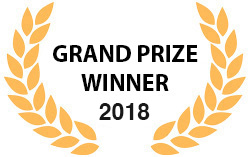

Brookhaven National Laboratory’s Center for Functional Nanomaterials (CFN) has developed a method for creating surface nanotextures that effectively eliminates optical reflections from glass, silicon, and plastics. This method leverages the patterning-forming abilities of thin films of block copolymers—an important class of industrial polymers used to manufacture many products, including shoe soles, adhesive tapes, and automotive interiors. Here, the block copolymers provide a physical template for plasma etching the glass surface into an array of nanometer (nm)-scale cone-shaped textures with sharp tips.
The nanotextures eliminate the abrupt change in refractive index at the air-material interface, thereby minimizing optical reflections. Glass surfaces covered with 300 nm tall cones reflect less than 0.2% of incoming red-colored light (633 nm wavelength), compared to 4% from untreated glass. When this technique is applied to both sides of a glass window, more than 99.7% of incident visible light is transmitted—making the glass essentially invisible. The nanotextured glass is antireflective over the entire visible and near-infrared spectrum and across a wide range of viewing angles. Even at viewing angles as high as 70°, more than 90% of light passes through the nanostructured glass, compared to 74% from untextured glass.
Unlike conventional thin-film antireflective coatings, this effect is not achieved by coating the glass with layers of different materials (typically polymers). Instead, the geometry of the surface itself is changed at the nanoscale. Because the final structure is composed entirely of glass, it is highly durable, withstanding 3x more optical energy per unit area than commercial broadband antireflective coatings. In addition to increasing light transmission, these glass surfaces can withstand cleaning products containing alcohol or other solvents, which typically cannot be used on antireflective coatings made with layered polymers.
This method of creating surface nanotextures is amenable to almost any type of material. To date, we have also applied it to silicon (for solar cells) and several types of plastic, including Teflon. The materials and processes required to create surface nanotextures by this method are compatible with standard thin-film manufacturing—for example, in the microelectronics industry.
The estimated small-volume material cost of our technique is currently $10/m^2 (based on retail block copolymer prices), but our conversations with Dow Electronic Materials indicate that volume-manufacturing material costs will be 10x lower, yielding a process cost of ~$1/m^2.
Invisible glass can
• Improve the consumer experience using smartphones, computers, and other electronic displays by eliminating glare (typical with the glass covers on most of today’s displays to protect against contaminants including dust and moisture)
• Enhance the energy-conversion efficiency of solar cells by minimizing the amount of sunlight lost to reflection
• Provide an alternative to the damage-prone antireflective coatings conventionally used in lasers that emit powerful pulses of light, such as those applied to manufacture medical devices and aerospace components
Through similar nanotexturing techniques developed at the CFN, the antireflective glass can also be manufactured to be water-repellent, self-cleaning, and anti-fogging—ideal properties for car and aircraft windshields.
Video
-
Awards
-
 2018 Grand Prize Winner
2018 Grand Prize Winner -
 2018 Top 100 Entries
2018 Top 100 Entries
Like this entry?
-
About the Entrant
- Name:Ariana Manglaviti
- Type of entry:teamTeam members:Charles T. Black, Center for Functional Nanomaterials, Brookhaven National Laboratory, Upton, NY 11973
Andreas C. Liapis, Wellman Center for Photomedicine, Massachusetts General Hospital, Harvard Medical School, Cambridge MA 02139
Atikur Rahman, Department of Physics, Indian Institute of Science Education and Research, Pune, Maharashtra 411008, India - Patent status:pending

